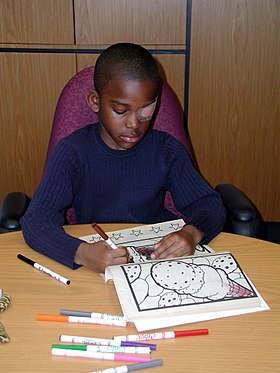Eye patch
| Eyepatch | |
|---|---|
| Intervention | |

A child wearing an adhesive eyepatch to correct amblyopia
|
An eyepatch or eye pad is a small patch that is worn in front of one eye. It may be a cloth patch attached around the head by an elastic band or by a string, an adhesive bandage, or a plastic device which is clipped to a pair of glasses. It is often worn by people to cover a lost or injured eye, but it also has a therapeutic use in children for the treatment of amblyopia. (See orthoptics and vision therapy.) Eyepatches used to block light while sleeping are referred to as a sleep mask. Eyepatches associated with pirates are a stereotype originating from fiction.
An eyepad or eye pad is a soft medical dressing that can be applied over an eye to protect it. It is not necessarily the same as an eyepatch.
In the years before advanced medicine and surgery, eyepatches were common for people who had lost an eye. They were particularly prevalent among members of dangerous occupations, such as soldiers and sailors who could lose an eye in battle, as well as blacksmiths who used them to cover one eye for protection from sparks while working. While stereotypically associated with pirates, there is no evidence to suggest the historicity of eye patch wearing pirates before several popular novels of the 19th century (see Pirate Eyepatches below).
Eye patching is used in the orthoptic management of children at risk of lazy eye (amblyopia), especially strabismic or anisometropic amblyopia. These conditions can cause visual suppression of areas of the dissimilar images by the brain such as to avoid diplopia, resulting in a loss of visual acuity in the suppressed eye and in extreme cases in blindness in an otherwise functional eye. Patching the good eye forces the amblyopic eye to function, thereby causing vision in that eye to be retained. It is important to perform “near activities” (such as reading or handiwork) when patched, thereby exercising active, attentive vision.
A study provided evidence that children treated for amblyopia with eye patching had lower self-perception of social acceptance. To avoid a child from being socially marginalized by its peers due to the wearing of an eye patch, atropine eye drops may be used instead. This induces temporary blurring in the treated eye.
...
Wikipedia
